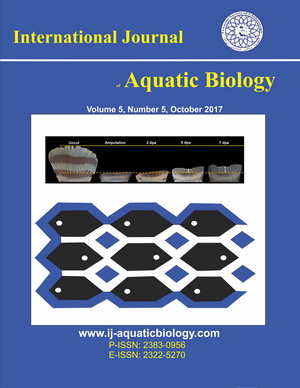Effect of temperature and pH on primary metabolic and biomass productivity culture in Euglena sp.
Downloads
Euglena is a microalga with the potential to be used as a renewable energy source. The biofuel-making potential is present in Euglena species biomass's proteins, lipids, and carbohydrates. Therefore, optimizing microalgal growth under various physiological conditions is crucial to obtaining more biomass. In this study, Euglena sp. was cultivated on medium Cramer-Myers (CM) and subjected to various temperatures and acidities. Euglena sp. cultures were optimized at different pH levels, including 2.5, 3.5, and 5.5, and at 29 and 32°C. Then, treatments were evaluated on the culture's pace of cell development, total biomass, and amount of carbohydrates, protein, and lipids. Based on the results, Euglena sp. at pH 5.5 and 29°C had the optimal growth rate, biomass, carbohydrate, protein, and fat content compared to the other treatments. In a pH 5.5 at 29°C, the average biomass was 0.382±0.173 g/L, and the resulting concentrations of protein, carbohydrates, and lipids of 0.288±0.12, 0.201±0.052, and 0.182±0.083 g/L, respectively.
Downloads
Becker E.W. (1994). Microalgae biotechnology and microbiology. Cambridge University Press. 293 p.
Bligh E.G., Dyer WJ. (1959). A rapid method of total lipid extraction and purification. Canadian Journal of Biochemistry and Physiology, 37: 911-917.
Breuer G., Lamers P.P., Martens D.E., Draaisma R.B., Wijffels R.H. (2013). Effect of light intensity, pH, and temperature on triacylglycerol (TAG) accumulation induced by nitrogen starvation in Scenedesmus obliquus. Bioresource Technology, 143: 1-9.
Buetow D.E. (1962). Differential effects of temperature on the growth of Euglena gracilis. Experimental Cell Research, 27: 137-42.
Bradford M.M. (1976). A rapid and sensitive method for quantifying microgram quantities of protein utilizing the principle of protein-dye binding. Analytical Biochemistry, 72: 248-254.
Chisti Y. (2007). Biodiesel from microalgae. Biotechnology Advances, 25: 294-306.
Cramer M., Myers J. (1952). Growth and photosynthetic characteristics of Euglena gracilis. Archive fur Mikrobiologie, 17: 384-402.
Dubois M., Gilles K.A., Hamilton J.K., Rebers P.A., Smith F. (1956). Colourimetric method for determination of sugars and related substances. Analytical Chemistry, 28: 350-356.
Ferreira G.F., Ríos Pinto L.F., Maciel Filho R., Fregolente L.V. (2019). A review on lipid production from microalgae: Association between cultivation using waste streams and fatty acid profiles. Renewable and Sustainable Energy Reviews, 109: 448-66.
Gissibl A., Sun A., Care A., Nevalainen H., Sunna A. (2019). Bioproducts from Euglena gracilis: synthesis and applications. Frontiers Bioengineering Biotechnology, 7: 1-16.
Harun R., Singh M., Forde G.M., Danquah M.K. (2010). Bioprocess engineering of microalgae to produce a variety of consumer products. Renewable Sustainable Energy Reviews, 14: 1037-1047.
Hayashi M., Toda K., Ishiko H., Komatsu R., Kitaoka S. (1994). Effects of shifting pH in the stationary phase of growth on the chemical composition of Euglena gracilis. Bioscience, Biotechnology, and Biochemistry, 58(11): 1964-1967.
Irhamni., Elvitriana., Viena V. (2014). Kultivasi Mikroalga Hijau Pada Sumber Nitrogen Berbeda Untuk Ekstraksi Lipida. Journal of Purifikasi, 14: 99-105.
Kawabata A., Kaneyama M. (1989). The effect of growth temperature on wax ester content and composition of Euglena gracilis. Microbiology, 135: 1461-1467.
Masojidek J., Kobližek M., Torzilo G. (2004). Photosynthesis in microalgae. In: A. Richmond (Ed.), Handbook of microalgal culture: Biotechnology and Applied Phycology. 584 p.
Mujahidah U. (2020). The effect of variation medium PH and environmental temperature on carbohydrate content, lipid and protein in treatment optimization of Euglena sp. cultivation. MSc. Thesis. Faculty of Biology. Universitas Gadjah Mada. 108 p.
Olaizola M. (2003). Commercial development of microalgal biotechnology: From the test tube to the marketplace. Biomolecular Engineering, 20: 459-466.
Olguín E.J., Mendoza A., González-Portela RE., Novelo E. (2013). Population dynamics in mixed cultures of Neochloris oleoabundans and native microalgae from the water of a polluted river and isolation of a diatom consortium for the production of lipid-rich biomass. New Biotechnology, 30: 705-715.
Suzuki K., Mitra S., Iwata O., Ishikawa T., Kato S., Yamada K. (2015). Selection and characterization of Euglena anabaena var. minor as a new candidate Euglena species for industrial application. Bioscience, Biotechnology, and Biochemistry, 79: 1730-1736.
Suzuki K. (2017). Large-scale cultivation of Euglena. Advances in Experimental Medicine and Biology, 979: 285-293.
Visviki I., Santikul D. (2000). The pH tolerance of Chlamydomonas applanata (Volvocales, Chlorophyta). Archives of Environmental Contamination and Toxicology, 38(2): 147-151.
Wang X., Liu X., Wang G. (2011). Two-stage hydrolysis of invasive algal feedstock for ethanol fermentation. Journal of Integrative Plant Biology, 53: 246-52.
Wang Y., Seppänen-Laakso T., Rischer H., Wiebe M.G. (2018). Euglena gracilis growth and cell composition under different temperatures, light and trophic conditions. PLoS One, 13: 1-17.
Copyright (c) 2024 International Journal of Aquatic Biology

This work is licensed under a Creative Commons Attribution 4.0 International License.








